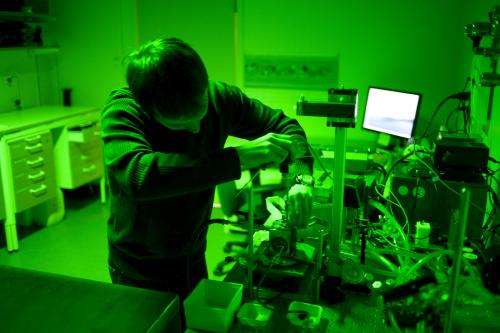Pioneering findings on the dual role of carbon dioxide in photosynthesis

Researchers at Umea University have found that carbon dioxide, in its ionic form bicarbonate, has a regulating function in the splitting of water in photosynthesis. This means that carbon dioxide has an additional role to being reduced to sugar. The pioneering work is published in the latest issue of the scientific journal PNAS.
It is well known that inorganic carbon in the form of carbon dioxide, CO2, is reduced in a light driven process known as photosynthesis to organic compounds in the chloroplasts. Less well known is that inorganic carbon also affects the rate of the photosynthetic electron transport and thus the rate of photosynthetic oxygen production. This result was first published by the Nobel Prize winner Otto Warburg and his collaborator in the late 50s.
Their explanation for the stimulating effect was logical at that time since they proposed that carbon dioxide was the source of the oxygen that plants produce. Their idea was proven to be incorrect many years later and instead we now know that water, H2O, is the source of oxygen in the atmosphere.
The observed stimulating effect by inorganic carbon on photosynthetic electron transport, has continued to cause an inflammatory debate among photosynthetic researchers around the world and resulted in hundreds of papers published on this issue.
"Our results will now put an end to this debate," says Johannes Messinger, Professor at the Department of Chemistry.
His research group has developed a very sensitive techniques based on "Membrane Inlet Mass Spectroscopy" that can be used to measure the production of gases in photosynthetic samples under analytically controlled conditions.
With this sensitive method they were able to test an earlier hypothesis that bicarbonate is acting as an acceptor for the protons that are produced when water is split in photosystem II. If so, a light driven production of carbon dioxide in addition to oxygen should be detected.
To their delight, the scientists could detect relatively large amounts of carbon dioxide in the mass spectrometric experiments.
"Therefore, it seems as if two different carbon species, both derived from the carbonic acid cycle, have got the optimal chemical properties to be used as terminal electron acceptor (CO2) in the very end of the photosynthetic reaction and at the same time as proton acceptor (HCO3-) in the very beginning of the photosynthetic reaction", says Johannes Messinger.
The results open up a new research field where researchers can investigate possible biological and ecological consequences of the dual role of carbon dioxide.
Artificial photosynthesis
In the search for a clean and renewable energy source researchers at Umeå University are studying photosynthesis with the purpose to create artificial photosynthesis devices. Their aim is to understand and model the complex reactions that take place in plant chloroplasts during photosynthesis in order to mimic natural photosynthesis in an "artificial leaf", an integrated unit that connects all important processes. If successful, it will be possible to convert sunlight directly into environmentally friendly energy carriers, for example into hydrogen gas.
More information: Sergey Koroidov, Dmitriy Shevela, Tatiana Shutova, Göran Samuelsson, Johannes Messinger: "Mobile hydrogen carbonate acts as proton acceptor in photosynthetic water oxidation." Umeå University. DOI: 10.1073/pnas.1323277111
Journal information: Proceedings of the National Academy of Sciences
Provided by Umea University


















